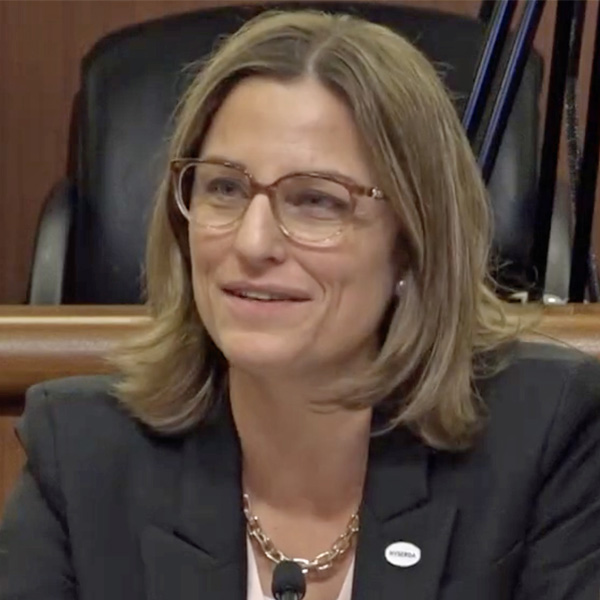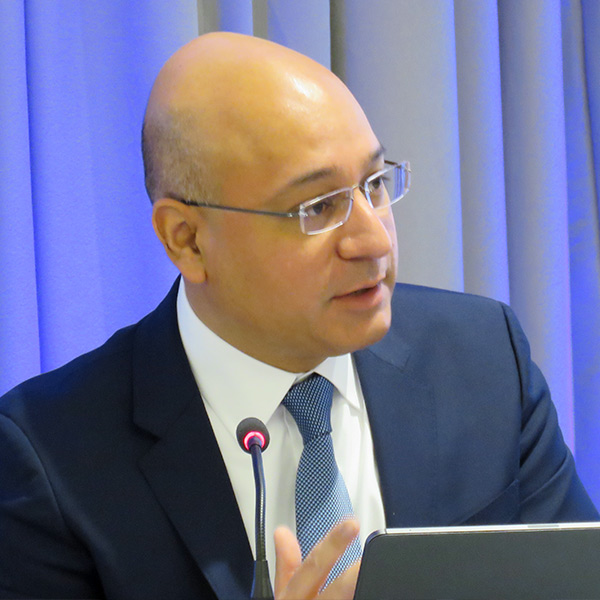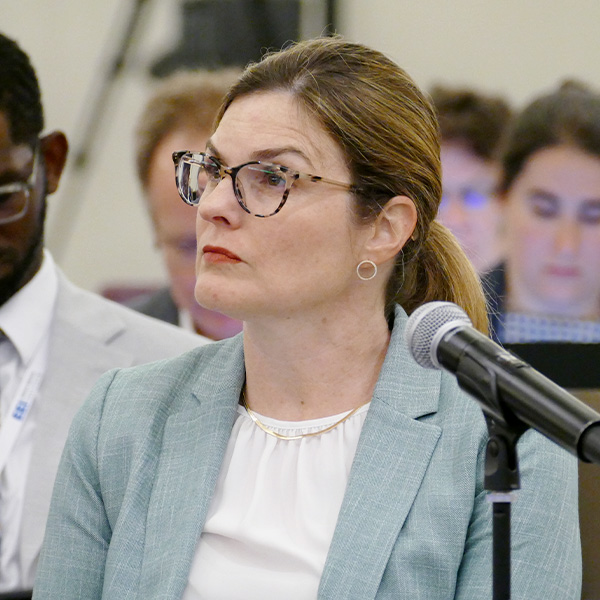State legislators peppered the leader of New York’s clean energy transition with questions Feb. 7 about the sputtering progress and controversial details of the effort, but got few firm answers.
Doreen Harris, president of the New York State Energy Research and Development Authority (NYSERDA), instead emphasized what has been long and widely known: It was a very tough year for renewable energy development, in New York as elsewhere, and the state is in the midst of a reset.
She urged that greater attention be paid to longer-term goals than to near-term targets that appear increasingly out of reach.
New York has a statutory requirement of 70% renewable energy by 2030, popularly known as 70×30; under questioning, Harris said the power portfolio stands at about 25% renewable now, much of that hydropower.
However, the pipeline of projects contracted but not constructed brings that total up to 63%, she added.
The accounting here is unclear — NYSERDA was placing its portfolio-plus-pipeline at 66% renewables a year ago, before contracts totaling 7.5 GW of renewable energy capacity were canceled.
Under additional questioning — friendly or pointed or rude, depending on the party affiliation or disposition of a given legislator — Harris appeared to concede that NYSERDA was counting canceled contracts toward the 63% total.
But a day later, her staff told NetZero Insider that in fact, 63% does reflect the subtraction of canceled contracts. The staff did not explain further but said the picture would be clearer this spring, after two rounds of new contract awards.
But the state has a way to go: The expedited onshore solicitation launched in late 2023 closed Jan. 31. Only 51 of the canceled projects were rebid. Six new bids brought the total to 57 projects with a combined 5-GW capacity.
The hope is that when the renewable energy industry returns to some semblance of pre-2023 normality, more projects with canceled contracts will be rebid.
A NYSERDA spokesperson said Feb, 8:
“As developers realign their project schedules and plans, NYSERDA is optimistic most will continue to take advantage of these competitive opportunities, helping New York’s pipeline continue to advance apace toward the 70×30 Climate Act goal and throughout the following decade.”
Public Perception
NYSERDA does not just lead the actual work of adding renewable energy capacity to New York’s grid, it works to build public support for the clean energy transition.
New Yorkers not only will be footing the enormous cost of the transition, they also will be called upon to make changes in their everyday lives to reduce their demand for power and emissions of greenhouse gases. Their buy-in is indispensable to the transition, literally and figuratively.
Wherever possible, Harris and her counterparts at other state agencies emphasize the benefits of change or the risks of the status quo in their public comments and sidestep the harder questions about the cost or even feasibility of their initiatives.
And so it was Feb. 7, when Harris and other office- or agency-level executives in the state government’s energy and environmental sectors appeared before a joint Senate-Assembly hearing about relevant portions of the budget proposed by their boss, Gov. Kathy Hochul (D).
It is an annual ritual held as the two legislative chambers prepare their own counterproposals, and it often goes beyond budget and policy line items to become a soapbox for issues dear to individual legislators and their core constituencies.
What impact it all has can be hard to determine, as legislative leaders and the governor take their three sets of proposals and hash out a final spending and policy package behind closed doors.
Republicans skeptical of the energy transition or its cost have little power to press their case, as Democrats hold both houses of the Legislature. But the Democrats are split regionally, and do not always present a unified bloc.
Much of the verbiage at the marathon hearing boiled down to the need to protect the planet and disadvantaged communities versus the high cost and uncertain means by which this will be attempted.
Environmental Conservation Commissioner Basil Seggos offered a frequent speaking point — the cost of maintaining the status quo will be greater than the cost of the transition. New York expects to sustain $55 billion in climate-related damage over the next 10 years alone, he said.
Seggos did not indicate whether New York’s energy transition would cost more or less than $55 billion, nor did he indicate what impact it would have in limiting global climate change, or when that benefit would start to manifest itself. New York totals 0.08% of the world’s land mass, is home to 0.25% of its people, and already has the smallest carbon footprint per capita or per unit of economic output of any U.S. state.
Badgered by a Republican senator on who would pay for all the multibillion-dollar clean energy projects she’s attempting to bring to reality, Harris said the cap-and-invest system the state is developing would place some of the cost on polluters rather than utility ratepayers.
She did not speculate on whether those same polluters might recoup those costs by reducing the number of New Yorkers they employ or raising the prices they charge new Yorkers for goods and services.
Looking at the huge increase in electrical use envisioned for the state — Harris said grid load might jump from 150 TWh a year now to 300 TWh by 2050 — one legislator said flatly there is no way intermittent wind and solar could meet that demand, and asked what else the state has in mind.
The Public Service Commission has initiated a case for just that reason, Harris said — to establish what constitutes a net-zero emissions grid. (See NY Drills Down on Statutory Meaning of ‘Zero Emissions’.)
She avoided mention of hydrogen, nuclear and other forms of energy that are anathema to most climate activists and made only generic reference to the as-yet-unknown technologies the state hopes will be brought to market in time to make a difference, and at an affordable price.
The Next Steps
While Harris was reticent to discuss the current state of New York’s renewable energy buildout, she spoke at length on how much the state is doing to rebound.
The state’s campaign to add solar, wind and storage capacity has been slow to produce results but had generated considerable momentum by the end of 2022 — much of which dissipated amid the industry troubles of 2023.
The Open NY database shows 109 contract cancellations totaling 11.2 GW as of Jan. 30, though it does not indicate when they were canceled. Some predate the mass cancelation of contracts that followed the state’s decision in October to not give developers more money to start construction of projects that had become financially untenable. (See NY Rejects Inflation Adjustment for Renewable Projects.)
(The cancellation total is effectively about 13 GW because the database does not count as canceled two offshore wind contracts totaling 1.74 GW that will be canceled but are still in place, for now.)
Since the October decision by the Public Service Commission to not grant a price increase to existing contracts, NYSERDA has been moving (at lightning speed by the standards of the regulatory world) to counter the expected rush of cancellations. (See New York Scrambles to Maintain Momentum in Energy Transition.)
It awarded provisional contracts to 22 onshore and three offshore renewable projects totaling 6.4 GW from the 2022 solicitations. (See NY Announces Renewable Energy Projects Totaling 6.4 GW.) It still is negotiating the final contracts, more than three months later.
It issued an expedited 2023 offshore wind solicitation that drew three bidders offering projects totaling 3 GW — two of which previously were contracted projects. (See Deflated New York OSW Portfolio Positioned to Start Regrowth.)
And it issued the expedited 2023 onshore solicitation, which drew bids for 57 projects totaling 5 GW, 51 of them rebids.
NYSERDA expects to announce provisional contract awards from the 2023 offshore solicitation later this month and from the 2023 onshore solicitation in April.
Whether New York still has a chance at meeting the 70×30 target mandated by the landmark Climate Leadership and Community Protection Act of 2019 remains to be seen.
“We’ve been talking a lot today about how we’re going to get to 2030,” Harris told the panel. “What we really need to be talking about more often is how we get to 2040 and 2050, given that this is a multidecade transition.”


